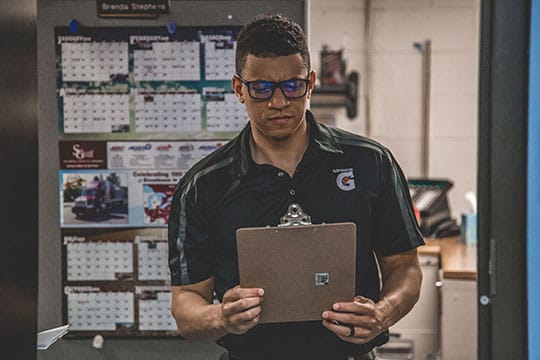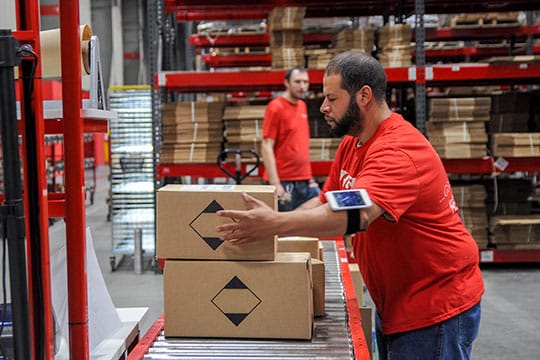When the right order doesn’t get to your customer, they’re going to be very upset. For eCommerce, “right” means the correct set of products delivered to the proper location on-time. No one is happily waiting extra days or weeks for your eCommerce order fulfillment team to get it right.
That’s a lot of pressure on everyone in your warehouse. Pressure leads to mistakes, unfortunately for us all. So, your mission as an eCommerce leader is to reduce the pressure on your team. In turn, they can make fewer mistakes and keep customers happier.
To help, we’re looking at five of the more common eCommerce order fulfillment mistakes that you can avoid with a little work, better processes, or a bit of help.
1. Not Knowing What You Have

When a customer buys from you, they expect to get a date the product will arrive, even if that’s a broad range. To give them a correct estimate, you have to know when you’re able to fill the order and ship it. If you don’t know your current inventory level, then you’re only guessing about being able to fill order number 17 or 33 for the day.
Poor inventory management can mean that you take in more orders than you can fill and don’t restock in time to meet demand. Or, it can go the other way where you’ve stacked a specific product in multiple locations and are restocking too early because your pickers don’t realize there’s more product elsewhere.
A lack of transparency can also increase other costs by making it take longer for pickers to complete an order, buying too much rental space for the amount of product you need to carry, having perishable inventory go bad because the oldest items are sitting below or behind newer ones, and so on.
Without a clear picture of your current inventory count, you’re only guessing about what you can do, how to use your inventory, and when you need to reorder or change. While you might do order fulfillment well for a while, no eCommerce business can get every guess right.
Recommended for you: UI vs UX Design: The Difference in User Interface & in User Experience.
2. Incorrect Product and Order Information

Incorrect information can kill an eCommerce business in multiple ways. For the fulfillment side of operations, there are two important things for you to be concerned about: descriptions and orders.
If the description of your products is incorrect, you can potentially face angry customers, poor reviews, and plenty of returns. Unfortunately, mistakes happen. If your site or sales channel has them, people will have the wrong expectations about your product. And, there’s no telling when those issues will cost you a sale.
For instance, say your product is 2 lbs. heavier than expected. It might not matter to someone who leaves it at home. But it can be a dealbreaker for someone who carries it on public transport to the office every day. If jewelry is mislabeled with the incorrect metal, you could give some customers a skin rash; they’ll definitely return the product. Or, if you label it as something safe, like sterling silver, you might get negative reviews claiming you’re trying to trick people. And something as simple as a hat being red but the photo on your website is pink can erode trust.
It harms repeat business (which every eCommerce brand needs) and can drive up your return rate, which burns through cash and labor.
eCommerce order information is also a risk, both on the customer and the fulfillment side. Incorrect shipping details can lead to returns or canceled orders when something takes too long. (Even before that, mislabeled fees can stop people from purchasing altogether).
We also hear about issues some small eCommerce stores have with setting price expectations for shipping. When they bring a box to a carrier’s store and the weight is wrong, or the size is too big for a standard shipment, or the shipping label printed at the warehouse is incorrect, all of these items add time and cost.
Carriers don’t like these mistakes either. Missteps can make it harder to establish a good relationship and start pursuing discounts as your volume increases.
3. Manually Providing Tracking Info
![]()
Customers are being ever-more demanding around their purchases and shipments. They want an immediate understanding of where things are and when they’ll arrive. If you’re delivering carrier tracking codes by hand — copying and pasting into emails or other notifications — you may not only delay their delivery but also leave yourself open to mistakes.
Human error happens. And, when it’s something like a tracking code that your customers will use to verify that a shipment is headed their way, that error will lead to helpdesk tickets and customer service issues.
If you have to process returns, manual data entry can make it more difficult to track orders as well. Your team needs to input the same information in multiple locations, which increases the chance for error or can duplicate it if something goes wrong. For instance, if your team copies the code wrong by leaving off the last letter or number, and then they paste this incorrect info into all customer emails and your spreadsheet, the disruption compounds.
Instead of trying to manage it by hand, look for an eCommerce platform or plugin that will automatically generate shipment information and tracking codes when an order is placed. This will significantly remove the chance for an error, and it allows customers to quickly opt-in for notifications from the carrier. Your customers will be happier with the information and your service team will enjoy fewer requests about tracking details.
Automate what you can to protect your business. Give yourself a further boost by looking for tools that use common APIs or can directly integrate with your email and CRM software. That connection makes it easier to share codes and details with customers. You can also track orders at every point in your system as well as your supply chain.
4. Running out of Space

eCommerce order fulfillment requires a lot of space. Most companies, especially eCommerce startups, give some thought to the warehousing space needed to physically hold goods. When starting out, you’ve got racks and shelves and maybe a table or two to keep things separate so you can understand inventory levels. Then, you grow to more storage and bins with better labels.
However, the warehouse space needed for everything else scales, too, as you grow. That means more equipment and places to store it. If there’s maintenance you need to do, such as on a forklift, then you need room for that to grow as your fleet expands. Busier warehouses require larger loading docks and more packing stations.
With growth here, you’re going to have a bigger team. That means enough lockers for their things, space in the breakroom for people to relax and each lunch, bathrooms, and so on. You’ll even need more space for management to do their daily tasks.
Every expansion of the product has ripples of expansion in the rest of your requirements. If you run out of space, for one thing, everything else gets cramped. That can mean frustrated workers who have to share a locker, or people not having enough room to walk to avoid bumping into a shelf or table. You’ll increase the likelihood of an accident with a forklift or cart. And, products that are doubled-up or stacked too high will risk being damaged.
Companies try to put up with having outgrown their space for as long as possible because it’s expensive to expand. You need to buy a new building or get a new lease, move everything, train people on the new layout, and ensure that you’ll still get access to existing carriers and other partners/relationships.
Ecommerce companies that outgrow their first space often tend to outsource order fulfillment instead of moving to a second location. The growth stage is right because they typically won’t have the cash flow to expand to a place they can be in for years (if they keep scaling). Working with a third-party logistics provider (3PL) that does fulfillment in their own warehouse means you’re only paying for specific space you use.
Don’t try to do everything in a cramped space. Look for new options and always include the possibility that you might be ready to outsource and offload some expansion costs.
5. Returns Don’t Have a Home

There’s a lot to eCommerce reverse logistics that can trip up small businesses and growing stores.
When someone returns a product, you need a system in place to handle the order. Review the items before adding them back into inventory. Check everything for damage or tampering. Otherwise, you risk selling a defective product to another customer and generating another return.
Logging in and controlling returns should be a core part of your warehouse software. You need to be able to process the return so you can automatically give someone a refund or replacement; then move the returns to QA checks. After the check, your warehouse tools should guide someone to put viable products back on your shelves; and the platform needs to accurately update inventory levels to reflect these additional products.
The more efficient you can make this process, the less harm a return will do to your business. Plus, customers are happier when your returns process is smooth. Research from the American Marketing Association in 2015 found that a customer-focused policy (meaning easy to understand and use) can increase your sales by 25%.
You may also like: How to Sell Products on Your Blog? 12 Noteworthy Tips for You!
Responding to These and More

A warehouse is a fast-paced environment; that speed is often what gets in the way for these five and other issues. When a team knows the existing processes, they may think they’re faster and resist changing. But that same rush introduces more chances for human error and accidents.
Look for opportunities to save your team time and work. Automation and warehouse management tools are a common first step. Because, many eCommerce platforms integrate with small inventory counters, order management options, and label generators, just to start. Taking time to plan your growth for tomorrow and a year down the road can help you with understanding space needs and looking for process gaps, like when returns are just tossed on a shelf and left for a month.
Your time is valuable, and sometimes that means using it to step back and look at the big picture. You can do it, your business can grow, and there’s plenty of time to get it right.





